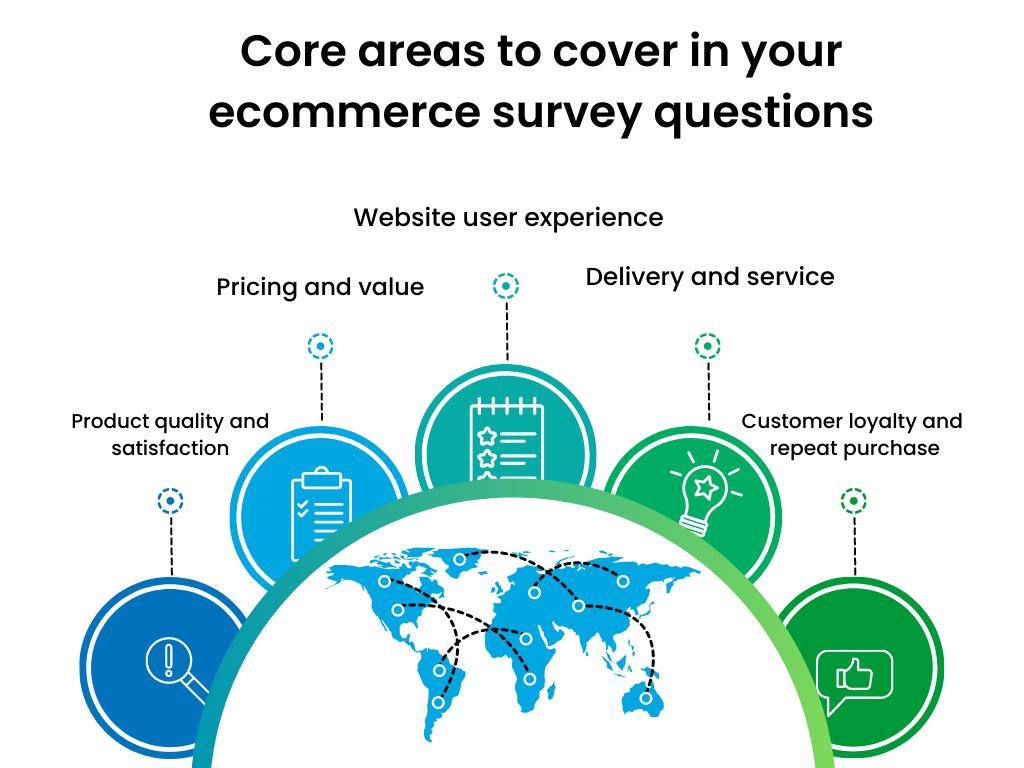The burgeoning world of ecommerce relies heavily on understanding the needs and wants of an increasingly discerning consumer base. This understanding comes not by chance but by carefully designed research mechanisms that prompt customers to share their thoughts and experiences. A central pillar of such mechanisms is conducting surveys. These simple yet powerful tools have become critical in gathering customer insights, fueling strategy, and driving growth. In essence, the design and execution of targeted ecommerce survey questions form the foundation for understanding customer sentiment and gathering invaluable feedback. This article will delve into the importance of such questions and provide guidance on crafting and utilizing them effectively.
The importance of ecommerce survey questions
Ecommerce survey questions play a crucial role in decoding customer behavior and their experiences. They open a window into the customer’s mind, revealing their likes, dislikes, and expectations about various facets of an ecommerce business. These aspects range from product quality, pricing, and website user experience to delivery and service standards. By dissecting the customer’s thoughts about these facets, businesses can gauge customer satisfaction and use the feedback to improve their offerings.
In an increasingly competitive ecommerce landscape, understanding and responding to customer feedback is key to standing out and staying ahead. Ecommerce survey questions enable businesses to do precisely that. These questions provide actionable data that helps refine business strategies, product offerings, and overall customer experience. They can identify existing gaps in the business’s offerings, provide early warning of potential issues, and reveal unexplored markets, all of which contribute to increased sales, customer retention, and enhanced customer loyalty.
Key components of an effective ecommerce survey
The crux of an ecommerce survey’s effectiveness lies in its questions. But what makes survey questions effective? Here are the key components of an ecommerce survey:
Clearly defined objectives
Before you start creating your survey questions, you should have a clear understanding of what you want to learn from it. Your objectives might include understanding customer satisfaction, getting feedback on a new product, or learning more about your customers’ buying behaviors.
Relevant and targeted questions
Your survey questions should be directly related to your survey’s objectives. The questions should be specific, concise, and clear, avoiding any jargon or technical language that could confuse respondents. Include both closed-ended questions for quantitative analysis and open-ended questions to gather qualitative data.
Easy-to-navigate design
A well-designed ecommerce survey is easy for respondents to understand and navigate. This includes a logical flow of questions, with simpler questions at the start to build rapport and more detailed or sensitive questions later.
Short and respectful of time
Keep your ecommerce survey as short as possible while still achieving your objectives. A shorter survey respects the respondent’s time and is more likely to be completed.
Balance of question types
Use a variety of question types (multiple choice, Likert scale, open-ended, etc.) to keep respondents engaged and to collect different types of data.
Anonymity and confidentiality
Assure your respondents that their responses will remain confidential. This will make your customer more likely to provide honest answers.
Clear and concise language
The language in ecommerce surveys should be clear and concise to avoid any misunderstanding. Avoid leading survey questions that may skew the data.
Proper timing and frequency
Choose the right time to send out your survey forms. If your survey is about a recent purchase, it might be best to send it out soon after the purchase while the experience is still fresh. However, be careful not to overwhelm customers with too frequent surveys.
Actionable results
The final and perhaps most crucial component is the follow-up action. The product feedback or the feedback about your store in general collected from the ecommerce survey should lead to meaningful changes that improve the customer experience and ultimately drive business growth. Respondents will appreciate seeing that their feedback has been taken into account, which can help build stronger relationships and loyalty.
Core areas to cover in your survey questions
Ecommerce businesses are multifaceted entities, each with its unique set of dynamics and interactions with customers. However, certain core areas are universally applicable when creating ecommerce survey questions. These include:

- Product quality and satisfaction. This revolves around gathering feedback on the quality, functionality, and overall satisfaction associated with your products.
- Pricing and value. This is about understanding how customers perceive your pricing structure and whether they feel they are getting the right value for their money.
- Website user experience. This aims to gain insights into the user-friendliness of your website and the overall shopping experience.
- Delivery and service. This focuses on customers’ experiences with your delivery timelines, packaging, and the quality of service received during and after the purchase.
- Customer loyalty and repeat purchase. This is to explore the likelihood of customers buying from you again and understanding the reasons that influence their decisions.
Each of these areas is a touchpoint in the customer’s shopping journey. By asking relevant questions about these touchpoints, you can create a comprehensive map of the customer experience, which can guide your strategies for improvement.
Examples of effective ecommerce survey questions
Creating an effective form for ecommerce survey questions means crafting questions that are clear, concise, and directly address the areas you want insights into. Here are some examples of effective ecommerce survey questions.
1. Survey questions about product quality and satisfaction:
- How would you rate the quality of the product you received?
- Did the product meet your expectations?
- Would you recommend our product to a friend or colleague?
2. Survey questions about pricing and value:
- How would you rate the value for money of our product?
- Compared to our competitors, do you think our prices are higher, lower, or about the same?
- Did you consider the product a good investment?
3. Survey questions about website user experience:
- How easy was it to find what you were looking for on our website?
- How would you rate your overall shopping experience on our website?
- Was the checkout process straightforward and easy to understand?
4. Survey questions about delivery and service:
- Were you satisfied with the delivery time of your product?
- Was the product packaged to your satisfaction?
- How would you rate our customer service?
5. Survey questions about customer loyalty and repeat purchase:
- How likely are you to purchase from us again in the future?
- Would you consider subscribing to a regular delivery of our product?
- How likely are you to recommend our website to a friend?
Remember, the specific questions you ask will depend on what information you’re seeking. These are just examples, and it’s important to tailor your questions to your business and your customer base for the most valuable insights.
How to implement and analyze ecommerce surveys
While creating effective ecommerce survey questions is a critical first step, knowing how to implement and analyze the survey is equally important.
Implementation
1. Choose the right platform
There are several online survey tools available that can help you design and distribute your ecommerce survey, such as Google Forms, SurveyMonkey, or Qualtrics. Choose one that fits your needs in terms of design flexibility, ease of use, and SaaS analysis capabilities.
2. Design the survey
Based on your objectives, design your ecommerce survey with a mix of open-ended and closed-ended questions. Make sure your questions are clear, concise, and easy to understand.
3. Test the survey
Before distributing your survey to all customers, test it on a small group first to make sure it’s working as intended and the questions are clear and relevant.
4. Distribute the survey
There are several ways to distribute your survey, including email, social media, or embedding it on your website. Choose a method that reaches the largest number of customers.
5. Timing and frequency
Choose the right time to distribute your survey – this could be immediately after purchase, at the end of the month, or after customer service interactions. Don’t overwhelm customers with too many surveys – find a balance that provides you with continuous data without annoying your customers.
Analysis
1. Collect responses
Give your customers ample time to respond to the survey. Once you’ve received a sufficient number of responses, close the survey and begin the analysis process.
2. Analyze quantitative data
Use statistical tools to analyze the quantitative data from your closed-ended questions. Look for trends, patterns, and significant statistical relationships.
3. Analyze qualitative data
Analyzing the responses to open-ended questions can be more challenging but also very insightful. Look for common themes or recurring issues that customers bring up.
4. Interpret results
Based on your analysis, draw conclusions about your customers’ experiences and preferences. Remember to keep the interpretation objective and focused on your initial objectives.
5. Action planning
Use the insights gained from the survey to inform your business decisions. This could mean making changes to your products, your customer service, or your website. Develop an action plan based on your findings.
6. Follow-up
Once you’ve made improvements based on the survey results, let your customers know. This shows them that you value their feedback and are committed to improving their experience.
Common mistakes to avoid in ecommerce surveys
While ecommerce surveys are valuable tools for gathering insights, it’s important to avoid common pitfalls that can compromise their effectiveness.
Unclear goals
Not having a clear objective for your survey can result in vague, irrelevant, or too many questions. Always have a clear goal or set of goals before you start crafting your survey.
Confusing or complicated survey questions
If questions are complex, use jargon, or are too technical, respondents might find them hard to understand, leading to inaccurate responses or low response rates.
Leading survey questions
Leading questions are framed in a way that they suggest a certain answer. This can skew your results and doesn’t provide accurate data. An example of a leading question would be, “Don’t you think our product is the best on the market?”
Too long survey questions
A long survey can be off-putting and may result in lower response rates or incomplete responses. Keep your survey short and to the point.
Ignoring the user experience
The design and layout of the survey should be user-friendly. A confusing or visually unappealing survey can lead to respondents abandoning the survey halfway.
Asking sensitive questions without a purpose
If you’re asking questions that could be viewed as intrusive or sensitive, ensure they’re necessary for your survey goals. Otherwise, they might make respondents uncomfortable and less likely to complete the survey.
Not testing the survey
It’s crucial to test your survey before you send it out. This can help identify confusing questions, technical glitches, or problems with the survey’s flow.
Neglecting to act on feedback
If you do not act on the feedback and make noticeable improvements, customers may feel their time was wasted, leading to lower response rates in the future. Always use the information gathered to drive positive changes.
Lack of follow-up
If possible, inform the participants about the results of the survey and the actions you plan to take based on the feedback. This closes the loop and shows respondents that their feedback is valued.
Ecommerce survey template
Here’s a simple ecommerce survey template:
Section 1: About you
1. How often do you shop online?
- Daily
- Weekly
- Monthly
- Rarely
2. What is your preferred device for online shopping?
- Desktop
- Mobile
- Tablet
- Other
Section 2: Product quality and satisfaction
1. How would you rate the quality of the product(s) you purchased?
- Very poor
- Poor
- Average
- Good
- Excellent
2. Did the product(s) meet your expectations?
- Yes
- No
- Somewhat
Section 3: Pricing and value
1. How would you rate the value for money of our product(s)?
- Very poor
- Poor
- Average
- Good
- Excellent
2. Compared to our competitors, do you think our prices are higher, lower, or about the same?
- Higher
- Lower
- About the same
Section 4: Website user experience
1. How easy was it to find what you were looking for on our website?
- Very difficult
- Somewhat difficult
- Neither easy nor difficult
- Somewhat easy
- Very easy
2. How would you rate the overall user experience on our website?
- Very poor
- Poor
- Average
- Good
- Excellent
Section 5: Delivery and service
1. Were you satisfied with the delivery time of your order?
- Very dissatisfied
- Dissatisfied
- Neutral
- Satisfied
- Very satisfied
2. How would you rate our customer service?
- Very poor
- Poor
- Average
- Good
- Excellent
Section 6: Customer loyalty and repeat purchase
1. How likely are you to purchase from us again?
- Very unlikely
- Unlikely
- Neutral
- Likely
- Very likely
2. Would you recommend our website to a friend?
- Definitely not
- Probably not
- Neutral
- Probably yes
- Definitely yes
Section 7: Additional comments
1. Do you have any suggestions on how we can improve our products, service, or website?
Remember, the goal of your survey should be to obtain actionable insights, so always analyze the responses and take the necessary actions to improve your ecommerce business.
Conclusion
Ecommerce survey questions are a powerful tool for any online retailer looking to understand their customers better and enhance their shopping experience. These questions, when carefully crafted and effectively utilized, can generate rich insights into various aspects of the customer journey. By focusing on key areas such as product quality, pricing, user experience, delivery service, and customer loyalty, ecommerce businesses can gather invaluable data to inform their strategies, improve their offerings, and ultimately drive their growth.
Read more about accounting automation.







.png)
